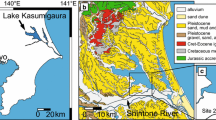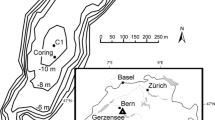Abstract
The apparent isotope enrichment factor εmacrophyte of submerged plants (εmacrophyte–DIC = δ13Cmacrophyte − δ13CDIC) is indicative of dissolved inorganic carbon (DIC) supply in neutral to alkaline waters and is related to variations in aquatic productivity (Papadimitriou et al. in Limnol Oceanogr 50:1084–1095, 2005). This paper aims to evaluate the usage of εmacrophyte inferred from isotopic analyses of submerged plant fossils in addition to analyses of lake carbonate as a palaeolimnological proxy for former HCO3 − concentrations. Stable carbon isotopic analysis of modern Potamogeton pectinatus leaves and its host water DIC from the Tibetan Plateau and Central Yakutia (Russia) yielded values between −23.3 and +0.4‰ and between +14.0 and +6.5‰, respectively. Values of εPotamogeton–DIC (range −15.4 to +1.1‰) from these lakes are significantly correlated with host water HCO3 − concentration (range 78–2,200 mg/l) (r = −0.86; P < 0.001), thus allowing for the development of a transfer function. Palaeo-εPotamogeton–ostracods values from Luanhaizi Lake on the NE Tibetan Plateau, as inferred from the stable carbon isotope measurement of fossil Potamogeton pectinatus seeds (range −24 to +2.8‰) and ostracods (range −7.8 to +7.5%) range between −14.8 and 1.6‰. Phases of assumed disequilibrium between δ13CDIC and δ13Costracods known to occur in charophyte swards (as indicated by the deposition of charophyte fossils) were excluded from the analysis of palaeo-ε. The application of the εPotamogeton–DIC-HCO3 − transfer function yielded a median palaeo-HCO3 − -concentration of 290 mg/l. Variations in the dissolved organic carbon supply compare well with aquatic plant productivity changes and lake level variability as inferred from a multiproxy study of the same record including analyses of plant macrofossils, ostracods, carbonate and organic content.





Similar content being viewed by others
References
Bade DL, Pace ML, Cole JJ, Carpenter SR (2006) Can algal photosynthetic inorganic carbon isotope fractionation be predicted in lakes using existing models? Aquat Sci 68:142–153
Benthien A, Zondervan I, Engel A, Hefter J, Terbrüggen A, Riebesell U (2007) Carbon isotopic experiment dominated by Emiliana huxleyi: effects on CO2 concentration and primary production. Geochim Cosmochim Acta 71:1528–1541
Birks HH (1973) Modern macrofossil assemblages in lake sediments in Minnesota. In: Birks HJB, West RG (eds) Quaternary plant ecology. Blackwell Scientific Publications, Oxford, pp 173–189
Birks HH (2001) 4. Plant macrofossils. In: Smol JP, Birks HJB, Last WM (eds) Tracking environmental change using lake sediments. Volume 3: terrestrial, algal, and siliceous indicators. Kluwer Academic Publishers, Dordrecht, The Netherlands
Brenner M, Whitmore TJ, Curtis JH, Hodell DA, Schelske CL (1999) Stable isotope (d13C and d15N) signatures of sedimented organic matter as indicators of historic lake trophic state. J Palaeolimnol 22:205–221
Burkhardt S, Riebesell U, Zondervan I (1999) Effects of growth rate, CO2 limitations and cell size on the stable carbon isotope fractionation in marine phytoplankton. Geochimica Cosmochima Acta 63:3729–3741
Elzenga JTM, Prins HBA (1988) Adaption of Elodea and Potamogeton to different inorganic carbon levels and the mechanism for photosynthetic bicarbonate utilisation. Aus J Plant Physiol 15:727–735
Fogel ML, Cifuentes LA (1993) Isotope fractionation during primary production. In: Engel MH, Macko SA (eds) Organic geochemistry: principles and applications. Plenum Publ. Corp., New York, pp 73–98
Freeman KH, Hayes JM (1992) Fractionation of carbon isotopes by phytoplankton and estimates of ancient CO2 levels. Global Biochem Cycle 6:185–198
Hemminga MA, Mateo MA (1996) Stable carbon isotopes in seagrasses: variability in ratios and use in ecological studies. Marine Ecol Prog Series 140:285–298
Herzschuh U, Zhang C, Mischke S, Herzschuh R, Mohammadi F, Mingram B, Kürschner H, Riedel F (2005) A late Quaternary lake record from the Qilian Mountains (NW China), evolution of the primary production and the water depth reconstructed from macrofossil, pollen, biomarker and isotope data. Global Planet Change 46:361–379
Herzschuh U, Kürschner H, Mischke S (2006) Temperature variability and vertical vegetation belt shifts during the last 50, 000 yr in the Qilian Mountains (NE margin of the Tibetan Plateau, China). Quatern Res 66:133–146
Hollander DJ, McKenzie JA (1991) CO2 control on carbon isotope fractionation during aqueous photosynthesis. A paleo pCO2 barometer. Geology 19:929–932
Keeley JE, Sandquist DR (1992) Carbon: freshwater plants. Plant Cell Environ 15:1021–1035
Leng MJ, Marshall JD (2004) Palaeoclimate interpretation of stable isotope data from lake sediment archives. Quater Sci Rev 23:811–831
Lucas WJ (1983) Photosynthetic assimilation of exogenous HCO3 − by aquatic plants. Ann Rev Plant Physiol 34:71–104
Lücke A, Schleser GH, Zolitschka B, Negendank JFW (2003) A Lateglacial and Holocene organic carbon isotope record of lacustrine palaeoproductivity and climatic change derived from varved sediments of Lake Holzmaar, Germany. Quatern Sci Rev 22:569–580
Maberly SC (1996) Diel, episodic and seasonal changes in pH and concentrations of inorganic carbon in a productive lake. Freshw Biol 35:579–598
Maberly SC, Madsen TV (1998) Affinity for CO2 in relation to the ability of freshwater macrophytes to use HCO3 −. Funct Ecol 12:99–106
Maberly SC, Spence DHN (1983) Photosynthetic inorganic carbon use by freshwater plants. J Ecol 71:705–724
Mischke S, Herzschuh U, Zhang C, Bloemendal J, Riedel F (2005) A late Quaternary lake record from the Qilian Mountains (NW China): lake level and salinity changes inferred from sediment properties and ostracod assemblages. Global Planet Change 46:337–359
Mischke S, Herzschuh U, Massmann G, Zhang C (2007) An ostracod-conductivity transfer-function for Tibetan lakes. J Paleolimnol 38:509
Mook WG, Bommerson JC, Staverman WH (1974) Carbon isotope fractionation between dissolved bicarbonate and gaseous carbon dioxide. Earth Planet Sci Lett 22:169–176
Morrill C, Overpeck JT, Cole JE, Liu K-B, Shen C, Tang L (2006) Holocene variations in the Asian monsoon inferred from the geochemistry of lake sediments in central Tibet. Quatern Res 65:232–243
Oana S, Deevey ES (1960) Carbon 13 in lake waters and its possible bearing on paleolimnology. Am J Sci 258:253–272
Osmond CB, Valaane N, Haslam SM, Uotila P, Roksandie Z (1981) Comparisons of δ13C values in leaves of aquatic macrophytes from different habitats in Britain and Finland; some implications for photosynthetic processes in aquatic plants. Oecologia 50:117–124
Papadimitriou S, Kennedy H, Kennedy DP, Borum J (2005) Seasonal and spatial variation in the organic carbon and nitrogen concentration and their stable isotopic composition in Zostera marina (Denmark). Limnol Oceanogr 50:1084–1095
Papadimitriou S, Kennedy H, Rodrigues RMNV, Kennedy DP, Heaton THE (2006) Using variations in the chemical and stable isotopic composition of Zostera noltii to assess nutrient dynamics in a temperature seagrass meadow. Org Geochem 37:1343–1358
Parplies J, Lücke A, Vos H, Mingram J, Stebich M, Radtke U, Han J, Schleser GH (2008) Late glacial environment and climate development in northeastern China derived from geochemical and isotopic investigations of the varved sediment record from Lake Sihailongwan (Jilin Province). J Paleolimnol 40:471–487
Pentecost A, Andrews J, Dennis PF, Marca-Bell A, Dennis S (2006) Charophyte growth in small temperate water bodies: extreme isotopic disequlibrium and implications for the palaeoecology of shallow marl lakes. Palaeogeogr Palaeoclimatol Palaeoecol 240:389–404
Pilon J, Santamaría Luis, Hootsmans M, van Vierssen W (2003) Latitudinal variations in life-cycle characteristics of Potamogeton pectinatus L.: vegetative growth and asexual reproduction. Plant Ecol 165:247–262
Prins HBA, Elezenga JTM (1989) Bicarbonate utilization: function and mechanism. Aquat Bot 34:59–83
Raven JA (1970) Exogenous inorganic carbon source in plant photosynthesis. Biol Rev 45:167–221
Romanek CS, Grossmann EL, Morse JW (1992) Carbon isotopes fractionation in synthetic aragonite and calcite: effects of temperature and precipitation rate. Geochimica Cosmochimica Acta 56:419–430
Sand-Jensen K (1983) Photosynthetic carbon sources of stream macrophytes. J Exp Bot 34:198–210
Steemann Nielsen E (1947) Photosynthesis of aquatic plants with special reference to the carbon-source. Dansk Botanisk Arkiv 12:1–71
Street-Perrott FA, Ficken KJ, Huang Y, Eglinton G (2004) Late Quaternary changes in carbon cycling on Mt. Kenya, East Africa: an overview of the δ13C record in lacustrine organic matter. Quatern Sci Rev 23:861–879
Stumm W, Morgan JJ (1970) Aquatic chemistry. An introduction emphasizing chemical equilibria in natural waters. Wiley-Interscience, New York
Vadstrup M, Madsen TV (1995) Growth limitation of submerged aquatic macrophytes by inorganic carbon. Freshw Biol 34:411–419
Van den Berg MS, Coops H, Simons J, Pilon J (2002) A comparative study of the use of inorganic carbon resources by Chara aspera and Potamogeton pectinatus. Aquat Bot 72:219–233
Van Wijk RJ, Van Goor EMJ, Verkley JAC (1988) Ecological studies on Potamogeton pectinatus L., II. Autecological characteristics, with emphasis on salt tolerance, intraspecific variations and isoenzyme patterns. Aquat Bot 32:239–260
Wijk Van (1988) Ecological studies on Potamogeton pectinatus L. Part I. General characteristics, biomass production and live cycles under field conditions. Aquat Bot 31:211–258
Wu Y, Lücke A, Wang S (2008) Assessment of nutrient sources and paleoproductivity during the past century in Longgan Lake, middle reaches of the Yangtze River, China. J Paleolimnol 39:451–462
Zhang J, Quay PD, Wilbur DO (1995) Carbon isotope fractionation during gas-water exchange and dissolution of CO2. Geochimica Cosmochimica Acta 59:107–114
Zhao Y, Sayer CD, Birks HH, Hughes M, Peglar SM (2006) Spatial representation of aquatic vegetation by macrofossils and pollen in a small and shallow lake. J Palaeolimnol 35:335–350
Acknowledgments
We are grateful to H.J.B. Birks and to two anonymous reviewers for their valuable comments and corrections. Furthermore, we are thankful to Katy Wilson who helped us with language correction.
Author information
Authors and Affiliations
Corresponding author
Electronic supplementary material
Below is the link to the electronic supplementary material.
10933_2009_9365_MOESM1_ESM.xls
Information on 68 studied sites on the eastern Tibetan Plateau (No. 1–56) and Central Yakutia (No. 57–68) in terms of location, lake depth and physical and chemical water properties (pH, alkalinity, ion activity). Furthermore, results on δ13CDIC, δ13Costracods, δ13C Potamogeton of leaf, δ13C seed of Potamogeton pectinatus seeds and apparent isotope enrichment factor εPotamogeton-DIC are provided. (XLS 33 kb)
Rights and permissions
About this article
Cite this article
Herzschuh, U., Mischke, S., Meyer, H. et al. Using variations in the stable carbon isotope composition of macrophyte remains to quantify nutrient dynamics in lakes. J Paleolimnol 43, 739–750 (2010). https://doi.org/10.1007/s10933-009-9365-0
Received:
Accepted:
Published:
Issue Date:
DOI: https://doi.org/10.1007/s10933-009-9365-0




